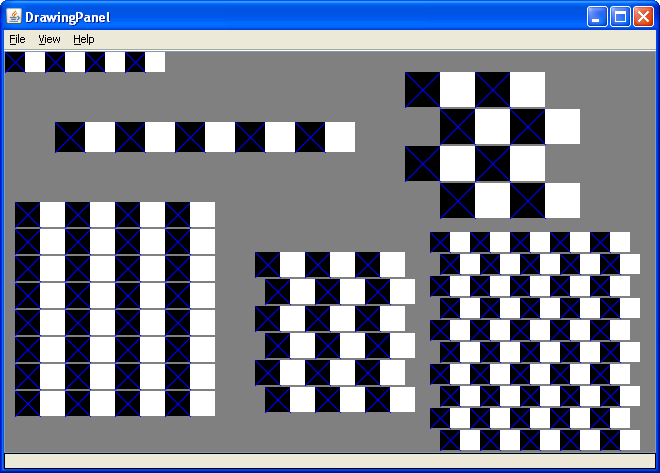handout #4
CSE142—Computer Programming I
Programming Assignment #3
due: Tuesday, 4/19/16, 11 pm
This assignment will give you practice
with for loops, value parameters, and graphics.
You will be using a special class called DrawingPanel written by Stuart Reges
and his coauthor Marty Stepp.
Part A: Doodle.java (2 points)
For
the first part of the assignment, turn in a file Doodle.java that draws a
figure using the DrawingPanel class. You
may draw any figure you like that is at least 100 x 100 pixels, contains at
least three shapes, uses at least two distinct colors, is your own work, and is
not highly similar to your figure for Part B.
Your program also should not have any infinite loops and should not read
any user input. Your score for Part A
will be based solely on external correctness as just defined; it will not be
graded on internal correctness.
Part
B: CafeWall.java (18 points)
In
the second part of the assignment we will be exploring something that is known
as the Café Wall illusion (as described in http://en.wikipedia.org/wiki/Caf%C3%A9_wall_illusion). You are to produce the image below. It has a size of 650 pixels by 400 pixels and
has a gray background.

This
image has several levels of structure. Black
and white squares are used to form rows and rows are combined to form
grids. The output has two free-standing
rows and four grids. You should first
write a method to produce a single row.
Each row is composed of a certain number of black/white pairs of boxes
where each black box has a blue X in it.
The
free standing rows in the output have the following properties:
|
Description |
(x,
y) position |
Number
of pairs |
Size
of each box |
|
upper-left |
(0, 0) |
4 |
20 |
|
mid-left |
(50, 70) |
5 |
30 |
Notice that we specify each row in terms
of how many pairs of black/white boxes it has.
Your method doesn’t have to be able to produce a row that has a
different number of black versus white boxes.
The boxes are specified using a single size parameter because each
should be a square. You should develop a
single method that can produce any of these rows by varying the position, the
number of black/white pairs, and the box size.
You will need to use one or more for loops to write this code so that it
can produce any of the various rows.
Once
you have completed this method, write a method that produces a grid of these
rows by calling your row method appropriately (you will again use one or more
for loops to solve this task). Grids are
composed of a series of pairs of rows where the second row is offset a certain
distance in the x direction relative to the first. The output has four grids with the following
properties:
|
Description |
(x, y) position |
Number of pairs |
Size of each box |
2nd row offset |
|
lower left |
(10, 150) |
4 |
25 |
0 |
|
lower middle |
(250, 200) |
3 |
25 |
10 |
|
lower right |
(425, 180) |
5 |
20 |
10 |
|
upper right |
(400, 20) |
2 |
35 |
35 |
Each grid is a square, which is why a
single value (number of pairs) indicates the number of rows and columns. For example, as the table above indicates,
the lower-left grid is composed of 4 pairs.
That means each row has four pairs of black/white boxes (8 boxes in all)
and the grid itself is composed of 4 pairs of rows (8 rows total). A single box size is again used because each
box should be a square. The offset
indicates how far the second row should be shifted to the right in each
pair. The figure in thelower-left has no
offset at all. The grid in the
upper-right is offset by the size of one of the boxes, which is why it has a
checkerboard appearance. The other two
grids have an offset that is in between, which is why they produce the optical
illusion (the rows appear not to be straight even though they are).
Each pair of lines in the grid should be
separated by a certain distance, revealing the gray background underneath. This is referred to as the “mortar” that
would appear between layers of brick if you were to build a wall with this
pattern. The mortar is essential to the
illusion. Your program should use 2
pixels of separation for the mortar, but you should introduce a program
constant that would make it easy to change this value to something else.
You are required to have the two methods
described above (one for a single row, one for a grid). We will expect you to use good style (indentation,
commenting, good variable names, etc) and to include a comment for the class
and for each method.
You should download DrawingPanel.java from
the class web page and save it in the same folder as your programs. Include the following line of code at the
beginning of your class file:
import java.awt.*;
You can use the DrawingPanel's image
comparison feature (File, Compare to Web File...) to check your output. Sample outputs are available for different
mortar settings. Two versions of each
output are provided because there are two slightly different approaches that
are each correct. You must match one of
each pair within 500 pixels for your output to be considered correct.
For this assignment you are limited to the
language features in Chapters 1 through 3G of the textbook. In particular, you should not use if/else
statements. Turn in your two program
files using electronic turnin. You do
not have to turn in DrawingPanel.java.